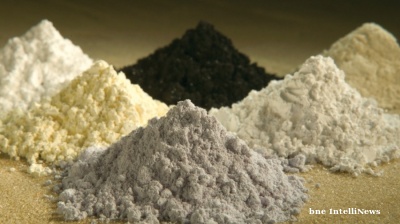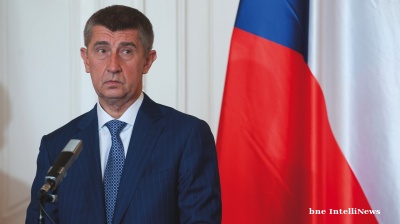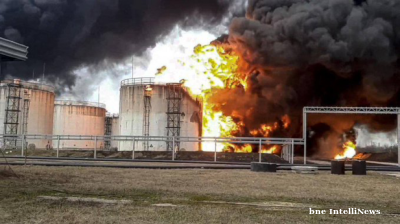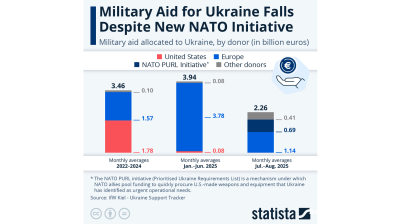KSE Institute has released its new August Russia Chartbook “Russia’s Overheating Economy Increasingly Hard To Manage.” The Russian government’s efforts to maintain macroeconomic stability are facing growing challenges, yet it still retains the capacity to manage them. To put more pressure on its economy and expose vulnerabilities, it is crucial for Ukraine’s allies to consistently strengthen sanctions against Russia.
The Russian economy is showing signs of weakening as activity in several key sectors slowed down in June, largely due to tighter monetary policies. Despite the central bank raising its policy rate to 18%, a significant increase since early 2023, inflation continues to rise. This suggests that managing the economy amidst war and sanctions is becoming increasingly challenging, even though headline indicators like GDP remain strong.
Favourable external environment continues to ensure Russia’s macroeconomic stability. Although Russia’s current account shifted to a deficit in July due to weaker exports, stronger imports, and larger service and income deficits, the January-July surplus reached $39.7bn, nearly 70% higher than the same period in 2023. This growth was mainly due to a $13.5bn increase in the trade surplus, driven by reduced imports and stable exports, with higher oil revenues balancing weaker exports of other goods.
Oil revenues remain high due to weak enforcement of energy sanctions. In July, the discount on Russian oil export prices—a key indicator of price cap enforcement—dropped to its lowest level since the start of the full-scale invasion, at $10.6 per barrel. This allowed Russia to earn an extra $15 per barrel of crude oil, totalling approximately $2.2bn. The reduced discount is partly due to the limited vessel designation campaign, which has enabled Russia to rebuild its shadow fleet capacity.
As a result, strong profits have contributed to Russia not facing major fiscal constraints. Over the first seven months of 2024, Russia’s federal budget deficit reached RUB1.4 trillion, which is 64% of the full-year target and 47% less than the same period in 2023. A significant 36% increase in revenues more than offset a 23% rise in spending.
These factors maintain the stability of the Russian economy, but vulnerabilities remain. While Russia is on track to meet its 2024 deficit target, significant risks are emerging, including a slowing economy, attacks on oil infrastructure, increased spending due to the Kursk situation, and rising borrowing costs. Reduced financial reserves could pose a problem if the economy slows further. With the loss of $300bn in CBR reserves and decreased liquid assets in the National Wealth Fund, the Ministry of Finance may need to rely more on domestic borrowing, increasing debt service costs.
The widening of the oil price discount that occurred in the last quarter of 2023 has now been fully reversed. The vessel designation campaign’s limited nature has allowed Russia to replace lost transport capacities. Together with rising global oil prices, this has led to an average export price of close to $75/barrel in July

In January-July, oil export earnings averaged $17.1bn vs. $17.3bn in H2 2023 and $14.1bn in H1 2023. Budget revenues from oil were also roughly unchanged compared to H2 2023 but 75% higher than in H1 2023. Russia’s ability to fund its government and, thus, its war in Ukraine appears largely unconstrained by oil sanctions.

The current account slipped into deficit in July (-$0.5bn) after recording a surplus of $5.1bn in June. This was driven by weaker exports, higher imports, and larger deficits for services, and income & transfers. Nevertheless, the January-July 2024 surplus of $39.7bn is almost 70% bigger than the one in January-July 2023.
But the current account surplus is expected to improve markedly this year. Oil and gas earnings, in US dollarbn Current account and components, in US dollarbn Source: Bank of Russia, KSE Institute Source: Bank of Russia, KSE Institute O&G exports are projected to rise to $243bn in 2024 (vs. $235bn in 2023) before declining to $226bn in 2025. As a result, the current account surplus is set to rise to $72bn this year and $60bn next (vs. $51bn in 2023). In terms of its external accounts, this leaves Russia in a quite comfortable position and will limit any depreciation pressure.

The share of “unfriendly” countries’ currencies (e.g.,, EUR, GBP, JPY, CHF) in Russian trade has fallen sharply. Other currencies have risen for both exports and imports, while the has gained importance mostly for exports. These shifts have created a shortage of hard currency as net inflows from goods trade have essentially disappeared

Read the full report here.
The Kyiv School of Economics (KSE) is a bne IntelliNews media partner and a leading source of economic analysis and information on Ukraine. This content originally appeared on the KSE website.
Opinion

IMF: Global economic outlook shows modest change amid policy shifts and complex forces
Dialing down uncertainty, reducing vulnerabilities, and investing in innovation can help deliver durable economic gains.

COMMENT: China’s new export controls are narrower than first appears
A closer inspection suggests that the scope of China’s new controls on rare earths is narrower than many had initially feared. But they still give officials plenty of leverage over global supply chains, according to Capital Economics.

BEYOND THE BOSPORUS: Consumed by the Donald Trump Gaza Show? You’d do well to remember the Erdogan Episode
Nature of Turkey-US relations has become transparent under an American president who doesn’t deign to care what people think.

COMMENT: ANO’s election win to see looser Czech fiscal policy, firmer monetary stance
The victory of the populist, eurosceptic ANO party in Czechia’s parliamentary election on October 6 will likely usher in a looser fiscal stance that supports growth and reinforces the Czech National Bank’s recent hawkish shift.



